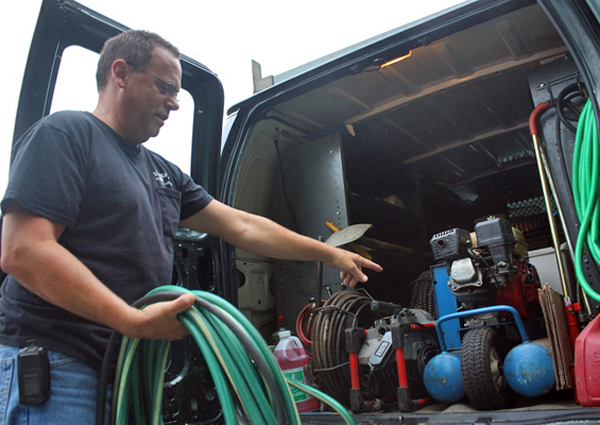
It’s almost a no-brainer preparing for the fall and winter. For most, all it takes is a shopping trip or two to the mall to buy thicker clothes, coats and boots and busting out the snow shovels and the snow salt.
But that seasonal checklist should also include ways to equip one’s home for the upcoming colder seasons, according to local builders and plumbers.
When temperatures drop, a home also feels it, particularly if it’s built from wood, which most homes on the East End are, said Al Giaquinto, owner of Plum Builders in East Hampton. Mr. Giaquinto offered plenty of tips on how to buckle up a home for the colder weather. Winterization is a process by which homeowners can prepare their residences through various means in anticipation of the cold, particularly if they do not plan on living here all year.
In an annual winterization checkup, there are at least three things Mr. Giaquinto looks out for: gutters, roofs and caulking.
Gutters should be inspected to make sure they are clean and properly functioning, he said. Gutters that are backed up often become problematic.
Roofs should be checked for ventilation. If the roof isn’t vented properly, Mr. Giaquinto says part of his winterization involves adding venting to the roof.
It’s also important to make sure the house is properly caulked, particularly where the siding meets windows and doors. That’s to ensure that water doesn’t enter the interior. The most important thing to guard the house against going into the colder seasons, said Mr. Giaquinto, is water.
“Water’s the big no-no,” he said.
Additionally, the paint on the house should be reviewed to make sure there are no cracks where the paint splits off from the house, so moisture doesn’t seep in, Mr. Giaquinto said, adding that water can really do a number on a paint job.
Aside from the negative effects of water on the exterior of the home, it can cause serious damage if it gets into the wood, Mr. Giaquinto said. Once inside, it could potentially freeze and expand, due to the cold weather. It can tear apart the wood, paint and shingles on a home.
“Out here, we have a lot of moisture because we’re surrounded by water,” he said. “And the key factor with water is that it freezes and thaws in the winter. And when it freezes and thaws, it creates the most damage.”
The long-term effects of water infiltration include rotten wood and possibly mildew. Repairing water damage could run well into the thousands, Mr. Giaquinto cautioned.
Gregory Grahn, an owner at Weber & Grahn Heating and Air Conditioning in Hampton Bays, offered much of the same kind of advice, while also emphasizing that it’s important to properly seal your home to prevent heat from escaping.
Insulating the attic and properly caulking a home is one of the frontline defenses against the weather, according to Mr. Grahn. It is more important than buying a high-tech piece of heating or cooling equipment, he said adding that the equipment is rendered useless if the house is drafty. Also, by properly insulating a home, the pipes are less likely to freeze, Mr. Grahn reported.
There are a few things to keep in mind with regard to heating and cooling systems while preparing for the upcoming weather. There is a federal tax energy credit available for certain types of energy-efficient equipment, according to the Energy Star website, said Mr. Grahn. Those who qualify can receive up to 30 percent, or a maximum of $1,500, off of biomass stoves, heating, ventilation and air conditioning, insulation, roofs, water heaters and windows and doors. The federal government is also offering a credit of 30 percent off of geothermal heat pumps, small wind turbines and solar energy systems, with no upper limit.
Homeowners should also be conscious of maintaining their current heating system, said Mr. Grahn. If the system is over 20 years old, Mr. Grahn recommended looking into a new one.
“Sometimes it’s better to replace something during the fall, first of all with the federal tax credit there, but replacing it during the fall instead of waiting for it to break at the worst time,” he said.
For those second-home owners who do not reside in their homes for the whole year, he suggested they invest in low-temperature alarms. Those alarms act as a safety measure by sounding off if the temperature in a home drops below a certain level, or if there is something wrong with the heating system.
Anthony Mulvey, owner of Hampton Bays plumbing company J.P. Mulvey Plumbing & Heating, Inc., said he also provides winterization checks each year for about 400 homes for those residents who do not live here during the winter. In that winterization—which typically costs approximately $100 and up, depending on the size of the house—Mr. Mulvey said his team evacuates all the water from all pipes in a home, secures the boilers so they can’t be turned on, and applies antifreeze to specific plumbing, including the traps, toilets and faucets, shut off mains and wells to avoid pipe freeze and bursting.
“That’s a full winterization,” he said. “You can turn the heat off in your house and walk away.”